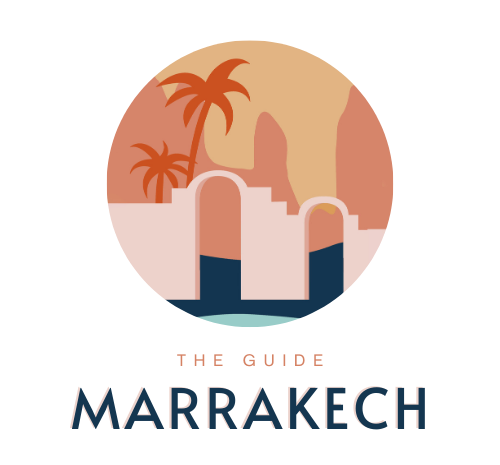What is Morocco Known For? 18 Reasons Morocco is Famous!
Wondering what is Morocco known for? Here are all the reasons the country is famous!
Morocco is known for its rich heritage and vibrant culture. Steeped in history and boasting a mix of Arab, Berber, and French influences, it’s no wonder that people are drawn to explore this captivating destination.
What is Morocco Known for?
1. Yves Saint Laurent
Yves Saint Laurent, the legendary French fashion designer, had a deep connection with Morocco. He first visited the country in 1966 and was immediately captivated by its vibrant culture, rich history, and stunning landscapes. He was particularly drawn to the city of Marrakech, where he eventually purchased a villa and spent much of his time.
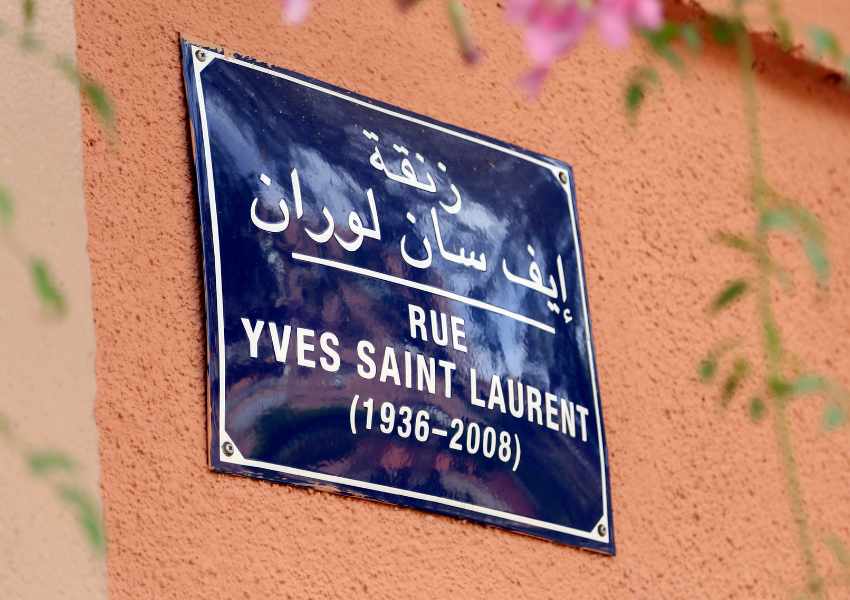
Saint Laurent’s love for Morocco is reflected in his work, as he frequently incorporated Moroccan-inspired designs and motifs into his collections. He also established the Fondation Pierre Bergé – Yves Saint Laurent in Marrakech, which houses a museum dedicated to his life and work.
In addition to his creative contributions, Saint Laurent was also a philanthropist who supported various charitable causes in Morocco. His legacy continues to be celebrated in the country, where he is remembered as a cultural icon and a champion of Moroccan art and fashion.
2. The Sahara Desert
The Sahara Desert is the largest hot desert in the world, covering an area of approximately 3.6 million square miles (9.4 million square kilometers). It spans across several countries in North Africa, including Morocco, Algeria, Tunisia, Libya, Egypt, Mauritania, Mali, Niger, Chad, and Sudan.
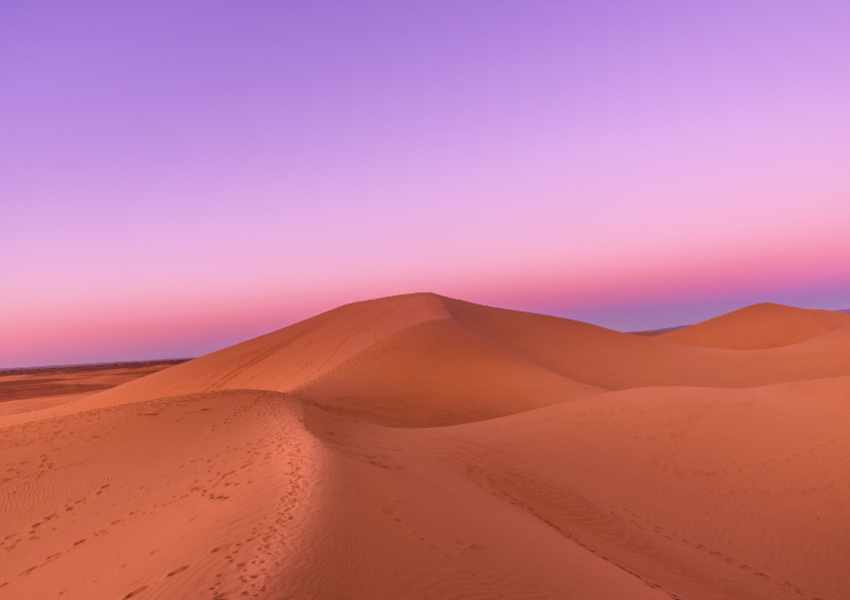
The Sahara Desert is characterized by its hot and arid climate, with temperatures often exceeding 120°F (49°C) during the day and dropping below freezing at night. The desert is also known for its vast sand dunes, which can reach heights of up to 600 feet (183 meters) and stretch for miles.
Despite its harsh conditions, the Sahara is home to a variety of plant and animal species, including camels, gazelles, and desert foxes. It is also home to several nomadic tribes, who have adapted to the desert’s conditions and rely on its resources for survival.
The Sahara has a rich history, with evidence of human habitation dating back thousands of years. It has been inhabited by various groups, including the Berbers, Arabs, and Tuaregs, and has been the site of numerous trade routes and cultural exchanges throughout history.
Today, the Sahara is a popular destination for tourists, who come to experience its unique landscapes, explore its ancient ruins and historical sites, and learn about its rich cultural heritage.
3. Textiles
Moroccan textiles are known for their intricate patterns, vibrant colors, and high-quality materials. They are an important part of the country’s cultural heritage and are highly valued both domestically and internationally.
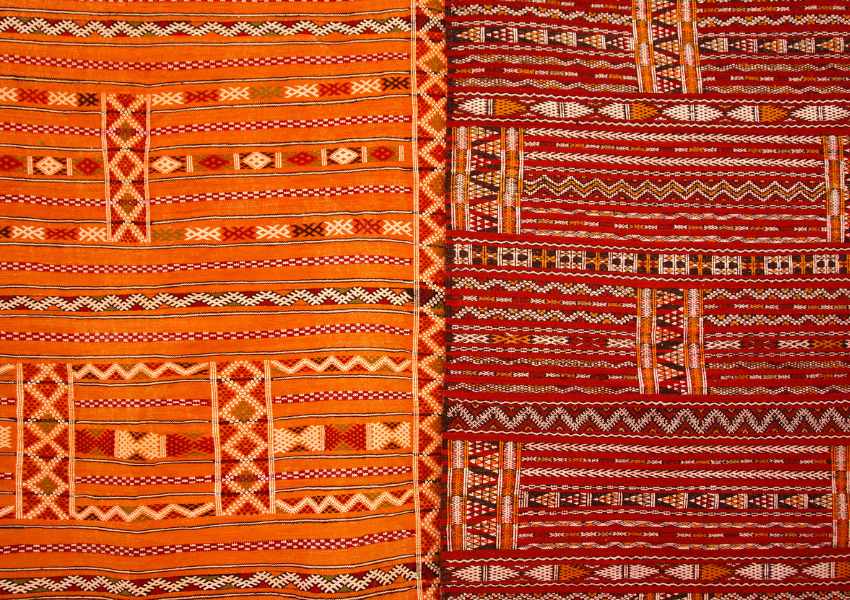
One of the most famous types of Moroccan textiles is the Berber rug, which is handwoven by Berber tribeswomen using traditional techniques that have been passed down through generations. These rugs feature bold geometric patterns and bright colors, and are often made from natural materials such as wool or cotton.
Another popular type of Moroccan textile is the Moroccan wedding blanket, also known as a handira. These blankets are traditionally given to brides on their wedding day and are made from wool, cotton, and sometimes silk. They are embellished with sequins and fringe, and often feature intricate patterns and designs.
Moroccan textiles also include a variety of other products, such as tapestries, pillows, and clothing. The traditional Moroccan djellaba, for example, is a long, loose-fitting robe worn by both men and women. It is often made from cotton or wool and features decorative embroidery or embellishments.
Moroccan textiles are often produced using traditional methods, such as hand-weaving or natural dyeing, and are known for their durability and longevity. They are also an important part of the country’s economy, with many artisans and craftspeople relying on the production and sale of textiles for their livelihoods.
4. Leather goods
Traditional Moroccan leather goods, such as bags and shoes, are highly valued for their quality craftsmanship and unique designs. They are often made using traditional techniques and natural materials, such as goat or camel leather.
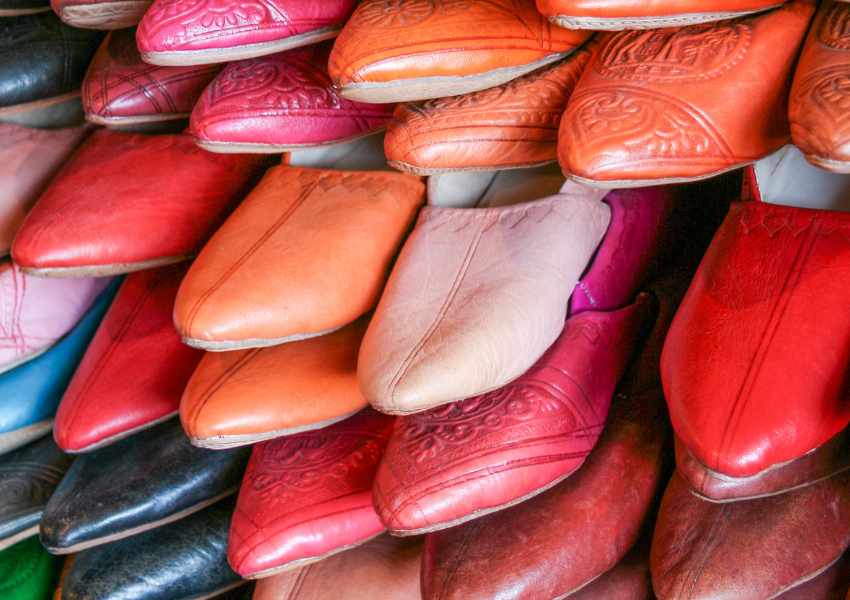
One of the most famous types of Moroccan leather goods is the babouche, a traditional slipper that is worn by both men and women. Babouches are typically made from soft leather and feature a pointed toe and curved upper. They are often embellished with decorative embroidery or tassels and come in a variety of colors and styles.
Moroccan leather bags are also highly sought after, with designs ranging from simple to ornate. One of the most popular styles is the saddlebag, which is inspired by traditional equestrian equipment and features a curved shape and leather straps. Other styles include the bucket bag, the tote bag, and the crossbody bag.
Moroccan leather goods are often produced using traditional techniques, such as tanning and dyeing, which have been passed down through generations. The tanning process, in particular, is known for its use of natural materials, such as vegetable dyes and olive oil, which help to create a soft and durable leather.
Moroccan leather goods are highly valued both domestically and internationally, and are an important part of the country’s economy. They are often sold in markets and souks throughout the country, and are a popular souvenir for tourists visiting Morocco.
5. Cactus Silk
Cactus silk, also known as Sabra silk, is a type of textile that is made from the fibers of the agave cactus plant. The production of cactus silk is a traditional craft in Morocco, where it is used to create a variety of products, including clothing, rugs, and decorative textiles.
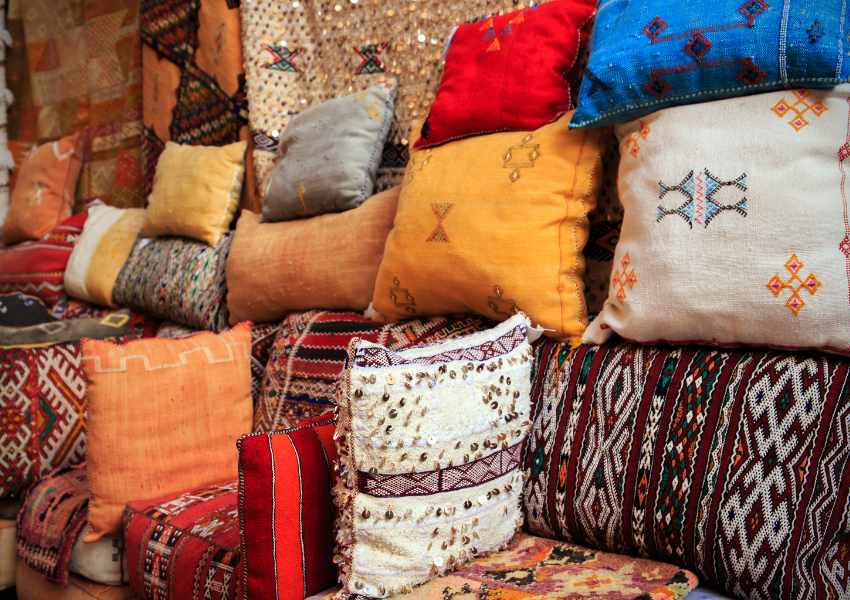
The process of making cactus silk involves several steps. First, the long, spiky leaves of the agave plant are harvested and soaked in water to soften the fibers. The fibers are then extracted by hand and spun into thread using a drop spindle. The thread is then dyed using natural dyes, such as henna or pomegranate, to create vibrant colors.
Once the thread has been dyed, it is woven into fabric using a traditional loom. The resulting fabric is soft and lightweight, with a texture that is similar to silk. It is often used to create decorative textiles, such as pillow covers and wall hangings, as well as clothing items like kaftans and scarves.
Cactus silk is highly valued for its unique texture and appearance, as well as its sustainability. The agave plant is abundant in Morocco and requires little water or maintenance to grow, making it a more eco-friendly alternative to other types of silk.
6. Surf Culture
Surf culture in Morocco has been growing rapidly in recent years, as the country’s long coastline and consistent waves have attracted surfers from around the world.
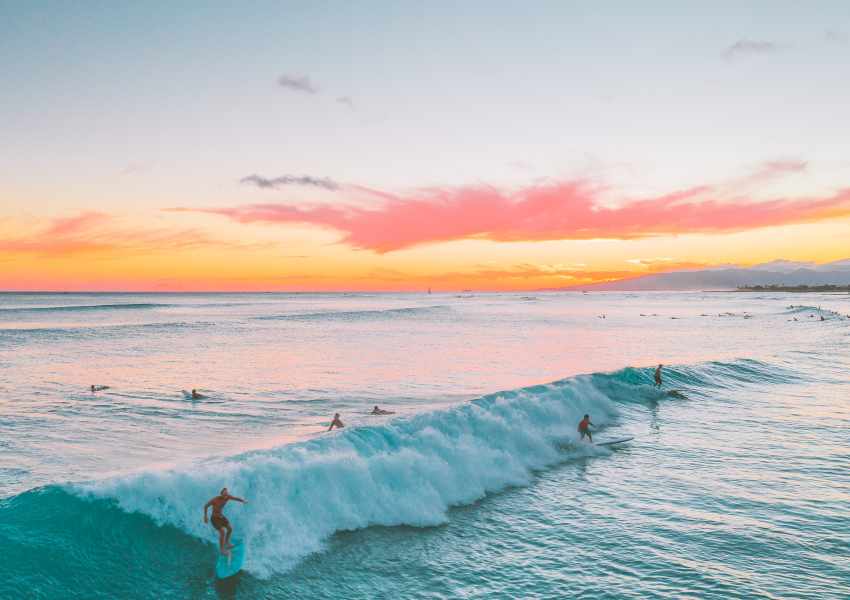
The country’s surf culture is characterized by a laid-back and welcoming vibe, with a strong emphasis on community and environmental sustainability.
One of the most popular surf destinations in Morocco is Taghazout, a small fishing village located on the Atlantic coast. Taghazout is known for its world-class waves, which attract surfers of all skill levels. The village has a thriving surf culture, with numerous surf schools, shops, and accommodations catering to surfers.
Surf culture in Morocco is also closely tied to the country’s traditional way of life. Many surf schools and camps are run by local Moroccans, who are passionate about sharing their love of surfing and their culture with visitors. Surfing in Morocco often involves experiencing local traditions, such as enjoying mint tea or eating traditional Moroccan cuisine.
Another important aspect of surf culture in Morocco is environmental sustainability. Many surf schools and organizations are committed to protecting the country’s coastline and marine life, and promote eco-friendly practices such as beach cleanups and responsible waste management.
7. Geographical Standpoint
When you think of Morocco, you might picture its striking landscapes and vibrant cities. Nestled in the northwest corner of Africa, this diverse country offers a unique blend of Arab, Berber, and French cultures. Let’s have a look at some of the geographical features that make Morocco so special.
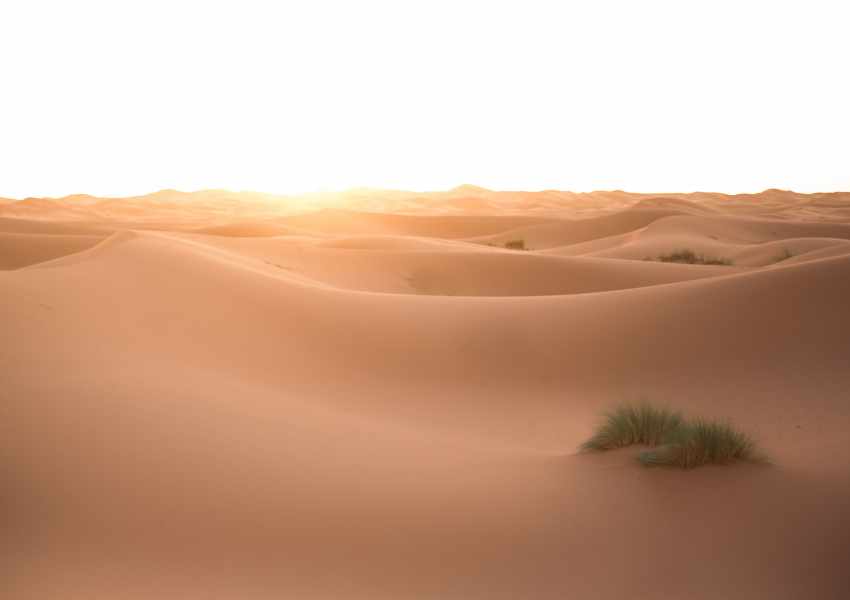
You’ll find Morocco bordered by the Atlantic Ocean and the Mediterranean Sea, which provide miles of stunning coastline, perfect for beach lovers. The coastal plains along the Atlantic coastline are fertile and great for agricultural activities. As you move inland, you’ll encounter the vast expanse of the Sahara desert, famous for its golden dunes and stunning sunsets.
In the heart of Morocco, the majestic Atlas Mountains offer incredible trekking experiences and breathtaking views. Split into three main ranges – the High Atlas, Middle Atlas, and Anti-Atlas – these mountains are home to the highest peak in North Africa, Mount Toubkal, standing at 4,167 meters.
Moreover, Morocco boasts of four main rivers, the Moulouya, Sebou, Oum Er-Rbia, and Draa, which provide vital water sources for irrigation and contribute to the country’s agricultural richness. These rivers also create picturesque landscapes and invite opportunities for outdoor activities such as kayaking and fishing.
Finally, Morocco’s diverse climate ranges from Mediterranean in the coastal regions to more extreme desert conditions in the south and east. This variation in climate allows for a wide range of flora and fauna, making Morocco an interesting destination for nature enthusiasts.
8. Symbolic Landmarks
When you think of Morocco, stunning landmarks like the Hassan II Mosque and Koutoubia Mosque may come to mind. These architectural masterpieces are not only symbols of faith, but also showcase the country’s cultural and historical identity.
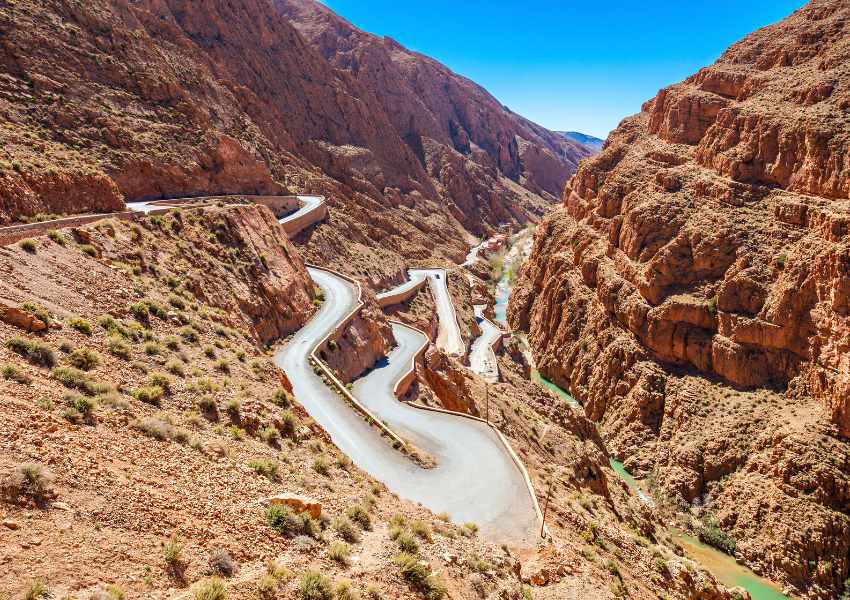
Stroll through the iconic blue city of Chefchaouen, where every corner feels like a step into another world. The city’s vibrant blue hues will transport you into the heart of Moroccan culture.
If you’re seeking to explore more of Morocco’s ancient history, don’t miss the Roman ruins of Volubilis. These well-preserved remnants are a testament to the diverse influences that have shaped Moroccan history, and a perfect example of Roman design and engineering.
To fully appreciate Morocco’s natural beauty, venture to the majestic Dades Gorge, where you’ll find yourself surrounded by towering red cliffs and zigzagging roads. Make sure to visit the picturesque Aït Benhaddou, a traditional mud-brick town that served as the backdrop for iconic movies like Gladiator and Game of Thrones.
9. Food and Cuisine
When you visit Morocco, you’ll quickly discover that the country is known for its rich and diverse food culture. Moroccan cuisine is influenced by Berber, Arab, French, and Mediterranean traditions, resulting in a unique and delicious array of dishes.
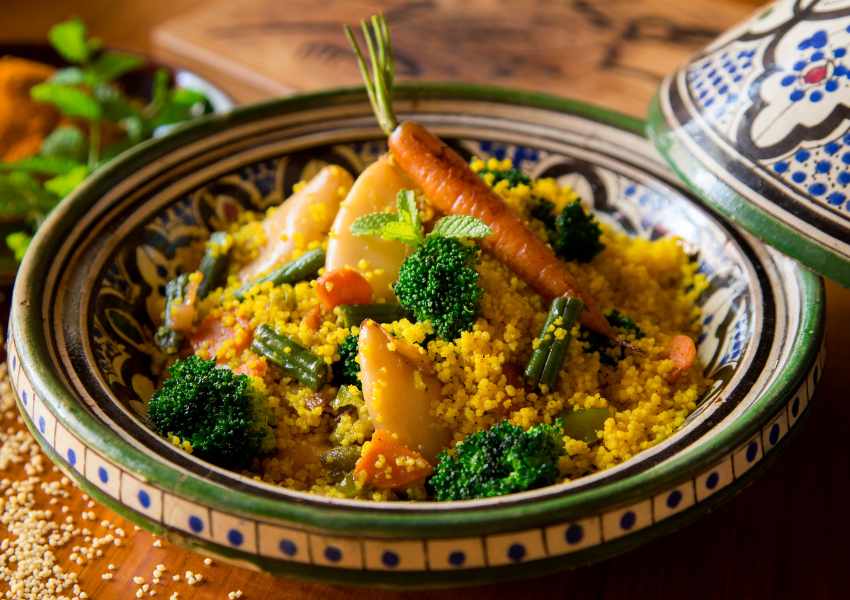
One must-try Moroccan specialty is couscous, which is steamed semolina grains served with vegetables, meat, or fish. It’s often cooked to perfection, with a delicate balance of spices and flavors. Another beloved dish is tagine, a slow-cooked stew made with meat, poultry, or fish, combined with vegetables, fruits, and nuts. The dish is named after the conical clay pot it’s cooked in, which helps to retain moisture and infuse the ingredients with flavor.
As you explore Moroccan cuisine, you’ll also encounter the country’s iconic bread, known as khobz. This round, crusty bread is a staple at every meal in Morocco and is used to scoop up tasty stews and sauces. Don’t miss out on trying local pastries and desserts, such as B’stilla – a sweet and savory pigeon pie delicately flavored with cinnamon and sugar.
In your culinary adventure, be sure to treat your taste buds to the diverse range of spices that Morocco has to offer. The most common and essential spice blend is Ras el Hanout, which translates to “head of the shop,” meaning a blend of the best spices a shop has to offer. This intricate blend typically consists of ingredients like cardamom, cumin, clove, cinnamon, and nutmeg, creating a symphony of flavors in each dish it’s used in.
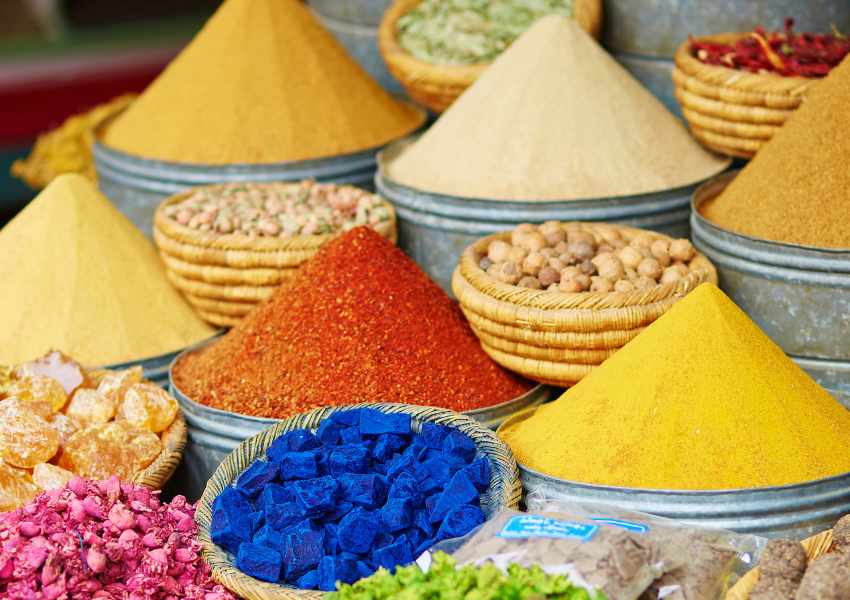
Morocco also boasts a fantastic tea culture. No visit to the country would be complete without indulging in a glass of Moroccan mint tea. This refreshing green tea is infused with fresh mint leaves and sweetened with sugar, creating a delightful drink that is enjoyed at all times of the day.
10. Cultural Heritage
You’ll find that Morocco is a melting pot of diverse cultures, blending Arab, Berber, and French influences throughout its long history. Walking through the streets of its ancient cities, such as Fes and Marrakech, you’ll be amazed by the well-preserved architecture and ornate designs that showcase the country’s rich cultural heritage.
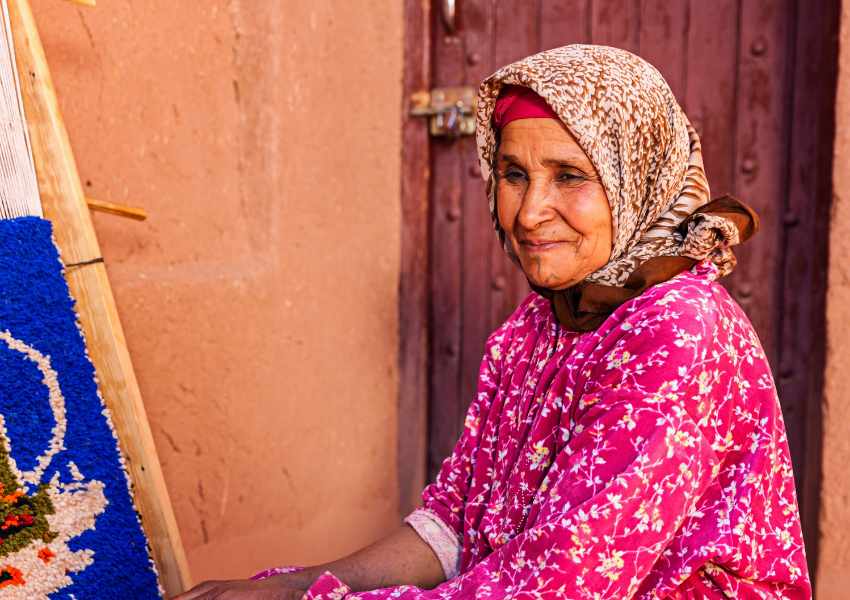
Moroccan cuisine is another facet of its cultural heritage you need to try. The distinctive blend of flavors brought by spices like cumin, paprika, and saffron reflect a mix of Berber, Arab, and European culinary influences. Make sure to taste their famous dishes like couscous, tagine, and pastilla.
Moroccan music and festivals play a significant part in the country’s cultural identity. You’ll find traditional music, such as Gnawa, Andalusian, and Berber styles, merging with modern, popular genres. Keep an eye out for local festivals like the Fes Festival of World Sacred Music and Marrakech’s International Film Festival, which provide an excellent opportunity for you to experience the vibrancy of Morocco’s cultural heritage.
Handicrafts, too, showcase the exceptional artistry of Moroccan people. From intricate pottery, colorful rugs, and finely crafted jewelry, you’ll be spoiled for choice when it comes to finding unique souvenirs to take back home. These handicrafts not only represent the Moroccan aesthetic but also stand as a testament to the skill and creativity ingrained in the Moroccan culture.
Remember to visit Morocco’s UNESCO World Heritage sites, which encompass impressive landmarks like the Ksar of Ait-Ben-Haddou, the Medina of Fes, and the ancient Roman ruins of Volubilis. These significant sites provide a glimpse into the country’s remarkable history and its enduring cultural legacy.
11. Traditional Practices
Morocco is known for its rich culture and traditions, which you’ll find woven into daily life. Some of these traditions include participating in various festivals, gatherings, and rituals.
For instance, you may come across Henna tattoo rituals. Often adorned during wedding celebrations or other special occasions, these beautiful temporary tattoos symbolize joy and good luck. You’ll find talented artists applying intricate henna designs on guests, adding a unique touch to the celebrations.
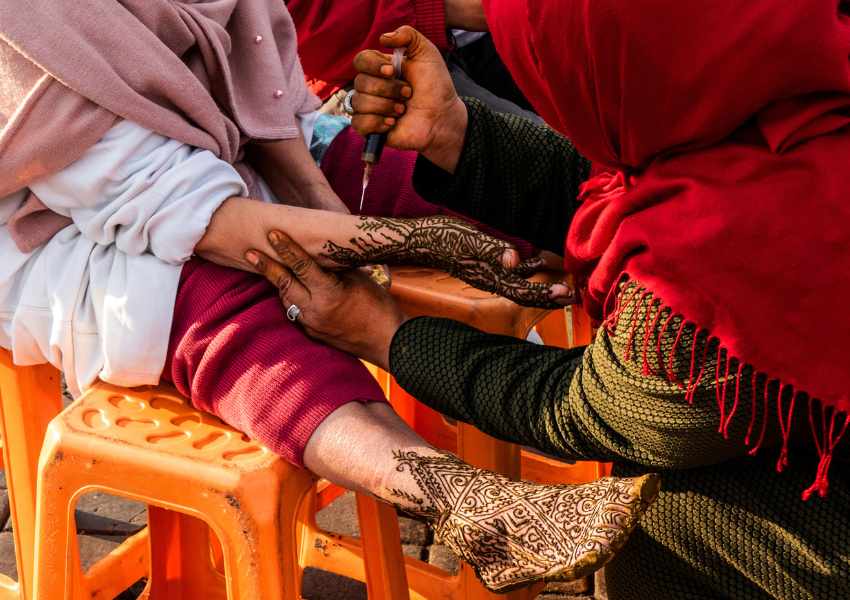
Morocco is also famous for its Hammams. These public bathhouses are an integral part of Moroccan culture. Visiting a Hammam offers you the chance to unwind and relax while experiencing the traditional bathing rituals. It fosters a strong sense of community and wellbeing among residents.
Another tradition that you’d find captivating is the Moroccan tea culture. Serving and drinking tea, particularly mint tea, is a way of life, and you’ll find people enjoying this sweet beverage at all hours of the day. It’s often linked to hospitality, as friends and families gather to celebrate special occasions or simply catch up over a glass of tea.
12. Famous Celebrities
You might be surprised to know that Morocco has produced some very famous celebrities. One of the biggest stars from this North African nation is Academy Award-winning French-Moroccan actress, Marion Cotillard. Born in Paris but strongly connected to her Moroccan roots, she has graced Hollywood with her talents in movies like La Vie en Rose and Inception.
Another renowned Moroccan celebrity is Najat Aatabou. Known for her distinctive voice and catchy tunes, Najat has become one of the country’s most admired singers. She is also an activist for women’s rights and an icon of the Amazigh music scene.
Have you ever heard of Saïd Taghmaoui? Well, you should! This actor has made quite a name for himself not only in Morocco but also in Hollywood. You may recognize him from movies like Wonder Woman and The French Kiss. He’s a perfect example of how Moroccan talents have gone on to achieve international recognition.
Here are a few more celebrities you might know:
- Rachida Dati: A powerful figure in European politics, the French-Moroccan politician held the prestigious position of Minister of Justice in France from 2007 to 2009.
- Abdelatif Benazzi: A former rugby union player, this Moroccan-born athlete represented both Morocco and France in international rugby competitions.
- Rajae Bezzaz: A talented Moroccan painter and visual artist whose work has been exhibited across Europe, the Middle East, and North America.
13. Notable Events
You might be wondering about the significant events that took place in Morocco. Let’s dive into a few remarkable moments in Moroccan history.
In 1956, Morocco achieved independence. After years of French and Spanish rule, Sultan Mohammed V led the country to freedom, signaling a new era for the nation.
Morocco witnessed the Green March in 1975, where approximately 350,000 unarmed Moroccans marched into Western Sahara. As a result, Spain agreed to give up control of the territory, making it a turning point in modern Moroccan history.
Another milestone includes Casa Festival, which takes place annually in Casablanca, the largest city in Morocco. It’s a remarkable celebration of art and culture, featuring concerts, exhibitions, and performances that attract many visitors.
During your stay in Morocco, don’t miss out on Marrakech’s International Film Festival. This event showcases talented filmmakers from around the world, taking place in November each year.
Lastly, the famous Gnaoua World Music Festival in Essaouira is a must-attend event for music lovers. With its roots in African rhythms, dance, and mysticism, this festival has gained global recognition, drawing thousands of visitors every year.
14. Influential Historical Figures
You might be curious about some of the influential historical figures that have shaped Morocco. Let’s dive right in and learn about a few of them.
Yusuf ibn Tashfin was the founder of the Almoravid dynasty and is well-known for uniting the Berber tribes in the region while spreading Islamic doctrine. Under his reign, the Almoravid empire reached its zenith, stretching from Senegal to Spain.
Next, you have Abd al-Rahman I, who was born in the 8th century. He managed to escape assassination by the Abbasids and fled to Spain, where he went on to establish the Emirate of Cordoba. His rule created a strong connection between Spain and Morocco in areas like culture, trade, and religion.
Of course, you can’t forget about Mehdi Ben Barka. He was a political dissident during the time of King Hassan II in the 20th century. Through his leadership, he greatly influenced the formation of modern Morocco as a politician and a teacher. Unfortunately, he was kidnapped in France and never seen again. His disappearance remains a mystery to this day.
And finally, King Mohammed VI is quite influential in Morocco’s present-day history. He ascended the throne in 1999, succeeding his father, King Hassan II. King Mohammed VI modernized the nation and reformed the political system, bringing about significant changes in human rights as well as women’s rights. Today, he’s considered a symbol of modernity and progress in the country.
These names are just a brief glimpse of Morocco’s rich tapestry of historical figures. Each of these individuals played important roles in shaping the culture, politics, and identity of the country and left lasting legacies that still impact Morocco today.
15. Moroccan Literature
You’ll find Moroccan literature to be an exciting blend of oral storytelling and written works. Having a rich history that reflects Arab, Berber, French, and Spanish influences, it is a melting pot of cultures and ideas.
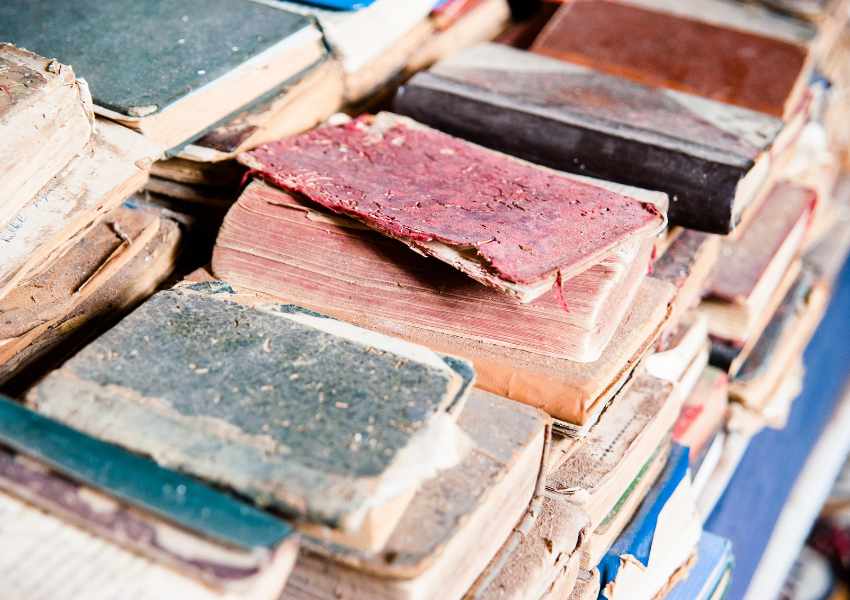
One of the most famous Moroccan writers you might have heard of is Tahar Ben Jelloun. This author has won numerous literary awards, including the prestigious Goncourt Prize. His successful books, such as The Sand Child and The Sacred Night, explore themes like identity, culture, and the struggles faced during Morocco’s process of modernization.
Moroccan literature also has a strong poetic tradition, with great poets like Abdellatif Laâbi and Mohammed Bennis. Their works often delve into the interplay of love, exile, and longing for one’s homeland. If you’re into poetry, take the time to explore and appreciate their heartfelt verses.
For a less conventional approach to Moroccan literature, you’ll want to check out Leila Slimani. Her novel, Lullaby, has gained international attention. It is an engaging thriller that takes the reader through the dark side of domesticity and power dynamics.
Finally, if you’re a fan of graphic novels, you’ll love discovering Moroccan writers like Zainab Fasiki. Her works focus on feminist themes, such as female empowerment and body positivity. In particular, her creation Hshouma: Art & Feminism in Morocco is a must-read.
16. Artistic Contributions
You might be curious about the artistic contributions that Morocco is known for, so let’s dive in. In the realm of visual arts, Morocco boasts a rich tradition of intricate craftsmanship, with zellige tilework, plaster carvings, and woodwork being just a few examples. These stunning pieces often adorn the interiors of homes, palaces, and mosques.
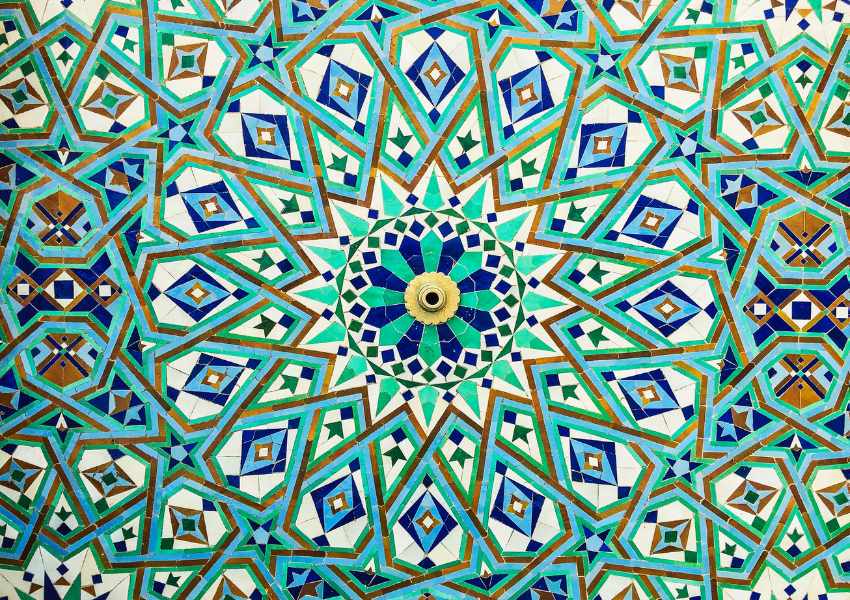
When it comes to music, you’ll find that Moroccan beats have strong roots in Amazigh, Arab, Andalusian, and African musical traditions. The country’s various regions contribute distinctly to this rich musical landscape. For example, the Gnawa people in southern Morocco have fused African rhythms with Berber and Arab-Andalusian influences, resulting in an enchanting and spiritual musical style.
In addition, Moroccan cinema has also made its mark on the international stage. The country has produced talented film directors like Nabil Ayouch and Faouzi Bensaïdi, whose works shed light on contemporary Moroccan society. You may have also noticed Morocco’s stunning landscapes used as filming locations for popular TV shows and movies, like Game of Thrones and Gladiator.
Finally, Moroccan literature has been thriving in recent years, bridging the gap between the old and the new. Esteemed writers like Fatema Mernissi, Tahar Ben Jelloun, and Leïla Slimani have authored novels that explore various aspects of Moroccan culture and society, offering a glimpse into the diverse lives of their characters.
17. Rare Species
In Morocco, you’ll encounter a diverse range of rare species that are native to the country. Some of these unique animals have adapted to the harsh desert environment, while others thrive in the lush green landscapes and forests.
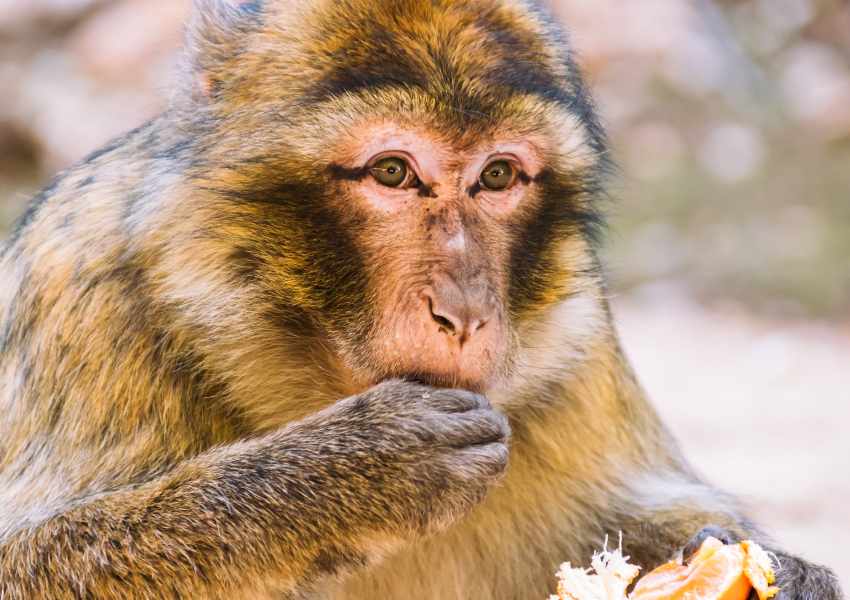
As you explore this magnificent country, you might be lucky enough to catch a glimpse of the Northern Bald Ibis. This rare bird, with its distinctive featherless head and curved bill, is one of the world’s most endangered birds. They can be spotted along the Atlantic coast in Souss-Massa National Park.
Don’t forget to keep your eyes peeled for the Barbary Macaque when you’re trekking through the Cedar Forests of the Middle Atlas. These endangered monkeys are known for their social behavior and are the only macaque species found outside Asia. But remember, it’s important to keep a safe distance and not to feed them.
Morocco is also home to the Moroccan Fennec Fox, a small, nocturnal fox with extremely large ears, which helps dissipate heat in the arid Sahara desert. If you’re exploring the desert at night, you may be fortunate enough to hear their high-pitched yelps as they communicate with each other.
In the water, you may come across the Mediterranean Monk Seal in remote coastal areas. A critically endangered species, these seals are recognized by their rounded heads and dark brown fur. Make sure to give them space, and consider yourself lucky if you catch a glimpse of one.
18. Sporting Success
Morocco has a rich sporting history that you might be excited to learn about. Football, in particular, is immensely popular in the country. Morocco’s national team, the Atlas Lions, has made a significant impact in international competitions. They participated in five FIFA World Cup tournaments, with their best performance in 1986 when they reached the quarter-finals.
Besides football, you’re likely to find locals passionate about athletics. Moroccan athletes have brought home numerous medals from prestigious events like the Olympics and World Championships. Hicham El Guerrouj is a name you may recognize. He’s a Moroccan middle-distance runner who holds world records in the 1500m, the mile, and the outdoor 2000m events.
If you’re into outdoor sports, Morocco’s diverse landscape offers fantastic opportunities for you. From surfing and windsurfing on the Atlantic coast to hiking and trekking in the rugged Atlas Mountains, you’ll find plenty of activities to satisfy your adventurous spirit. Golf is also slowly gaining traction, with several world-class courses that cater to both pros and amateurs.
In recent years, the popularity of motor sports has grown in the country. Morocco regularly hosts international events like the Rally of Morocco and the Marrakech Grand Prix. So if you’re a fan of fast-paced racing action, Morocco’s got you covered too.
What is Morocco Known For? Conclusion
In conclusion, Morocco is a country that is known for its rich history, diverse culture, and unique attractions. From the bustling markets of Marrakech to the stunning landscapes of the Sahara Desert, Morocco has something to offer for everyone.
Whether you’re interested in exploring ancient architecture in Casablanca, trying new food in Marrakech, or simply relaxing on the beach in Agadir, Morocco is a destination that should not be missed.
